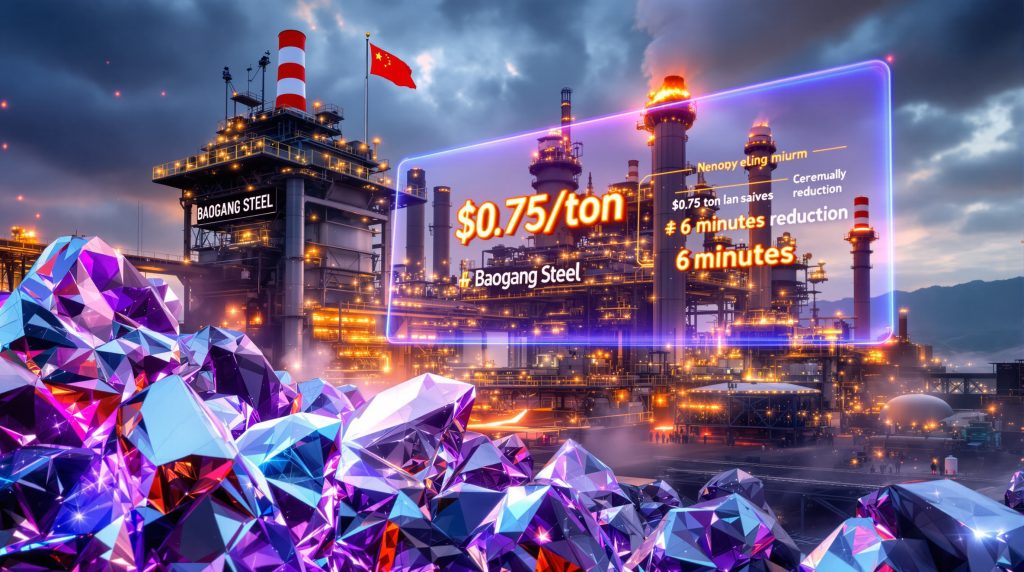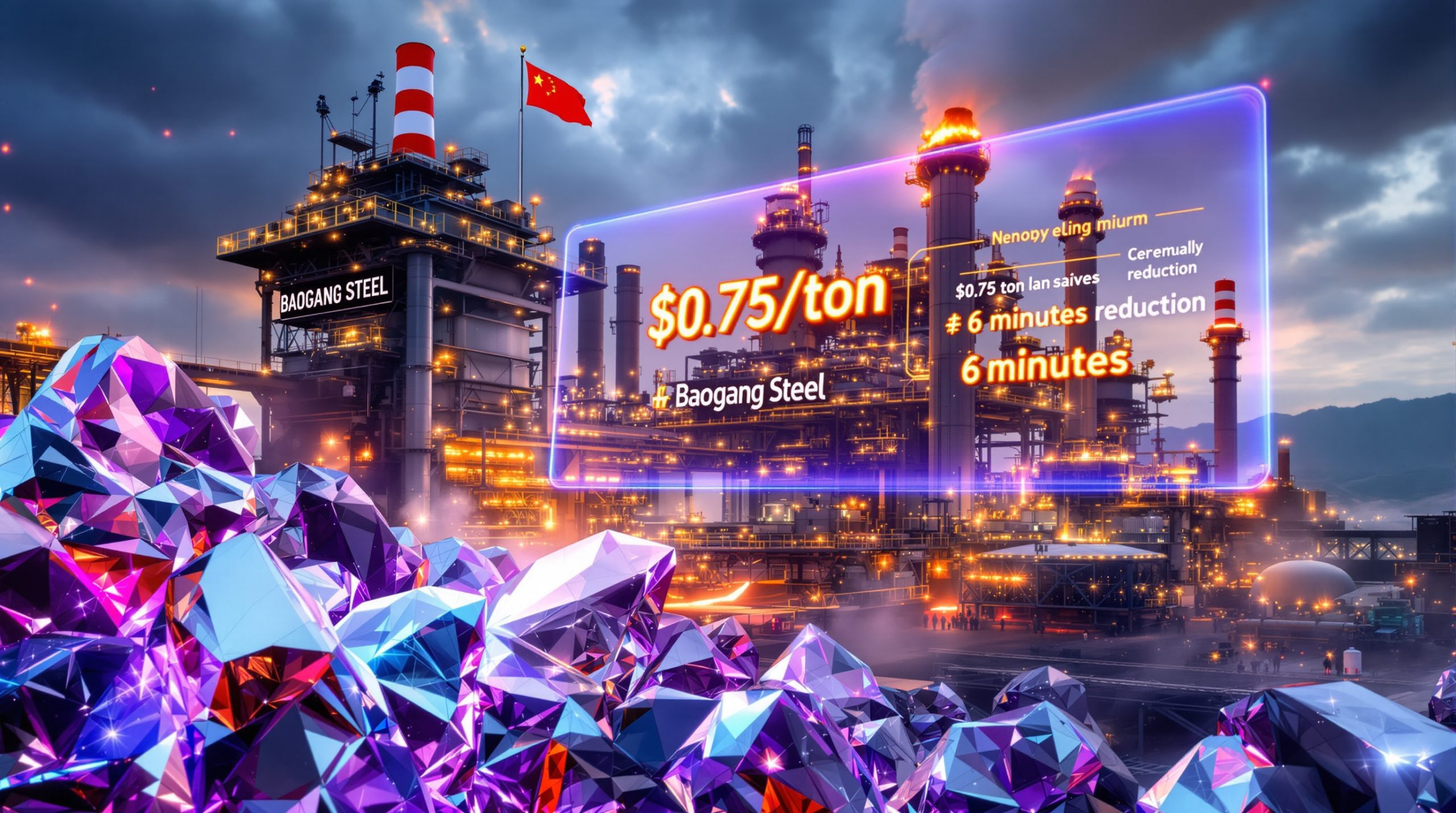Global industrial trends often reveal themselves through seemingly isolated technological breakthroughs. When examining metallurgical innovation patterns across major economies, the intersection of critical minerals energy access and manufacturing efficiency creates lasting competitive advantages. This dynamic becomes particularly pronounced in sectors where raw material control intersects with process engineering capabilities, fundamentally altering cost structures and market positioning.
The steel industry exemplifies this phenomenon, where traditional refining methods have remained relatively unchanged for decades. However, the integration of rare earth elements into established metallurgical processes represents a potential paradigm shift that could reshape global manufacturing competitiveness. Understanding these developments requires examining both the technical mechanisms involved and their broader strategic implications for industrial policy and supply chain dynamics.
Revolutionary Process Engineering in Steel Refining
The metallurgical breakthrough developed by China Baogang Steel represents a fundamental departure from conventional aluminum deoxidation methods that have dominated steel refining for generations. This China Baogang Steel rare earth refining breakthrough replaces standardised treatment approaches with customised rare earth applications tailored to specific steel grades.
Traditional steel refining relies heavily on aluminium deoxidation processes that follow a one-size-fits-all methodology. The new rare earth-enabled approach introduces grade-specific treatment protocols that eliminate entire processing steps whilst maintaining superior steel cleanliness standards. This represents more than incremental improvement; it constitutes a complete reimagining of how metallurgical processes can be optimised.
The technical foundation centres on what industry innovation trends describe as narrow-window process control parameters. These precise operational boundaries allow engineers to harness rare earth elements' unique metallurgical properties whilst avoiding the traditional inclusion-modification treatments that consume both time and resources in conventional steelmaking.
Quantified Performance Improvements and Economic Impact
The economic metrics associated with this China Baogang Steel rare earth refining breakthrough demonstrate substantial operational advantages across multiple performance dimensions. Cost reduction analysis reveals savings of approximately 5.5 yuan per ton of steel produced, equivalent to roughly $0.75 USD per ton at current exchange rates.
Processing efficiency improvements include a six-minute reduction in furnace processing time per cycle. Whilst this may appear modest, the cumulative impact across high-volume production facilities generates significant throughput gains. When applied to Baogang's reported 6 million tons of steel produced using this methodology, the operational benefits compound substantially.
Environmental performance metrics show measurable reductions in smoke emissions traditionally associated with aluminium deoxidation processes. This environmental benefit aligns strategically with China's industrial policy priorities focused on emissions reduction and manufacturing consolidation initiatives.
| Performance Metric | Traditional Method | Rare Earth Process | Improvement |
|---|---|---|---|
| Cost per ton | Baseline | 5.5 yuan savings | $0.75 USD reduction |
| Processing time | Standard cycle | 6-minute reduction | Improved throughput |
| Emissions profile | Aluminium deoxidation smoke | Reduced emissions | Environmental compliance |
| Production volume | N/A | 6 million tons | Scale validation |
The scale of implementation provides crucial validation for the technology's commercial viability. Production volumes reaching 6 million tons indicate successful transition from laboratory development to full-scale industrial application, though independent verification of these performance claims remains pending.
Strategic Implications for Global Manufacturing Dynamics
The competitive positioning implications of this China Baogang Steel rare earth refining breakthrough extend far beyond immediate cost savings or throughput improvements. Furthermore, China's structural advantages in rare earth supply chains create potential barriers to replication that could reshape global steel manufacturing dynamics.
Supply Chain Integration Advantages
China's control of massive critical minerals reserve in Inner Mongolia provides Baogang with unique supply chain advantages that Western manufacturers cannot easily replicate. This vertical integration spans from raw material extraction through specialised metallurgical applications, creating what industry analysts describe as a rare earth-reinforced supply chain moat.
The strategic significance becomes apparent when considering the specialised rare earth elements required for advanced metallurgical applications. Unlike commodity steel inputs, rare earth elements require sophisticated separation and purification processes that remain concentrated within Chinese industrial infrastructure.
Western steel manufacturers face structural disadvantages in accessing these materials at competitive costs. The combination of limited alternative supply sources and China's established processing capabilities creates dependency relationships that extend beyond simple raw material pricing considerations.
Market Segment Transformation Potential
Applications for this advanced steel refining technology span multiple high-value market segments where China seeks competitive advantage. Construction materials, automotive components, offshore wind turbine structures, and marine engineering applications represent markets where superior steel properties command premium pricing.
The China Baogang Steel rare earth refining breakthrough particularly impacts specialty steel segments including:
• Automotive steel grades requiring enhanced formability and strength characteristics
• Wind turbine steel plate demanding superior fatigue resistance and weather durability
• Wear-resistant machinery components operating under extreme industrial conditions
• Marine engineering materials requiring corrosion resistance and structural integrity
Each of these applications represents markets where quality differentiation justifies premium pricing. In addition, this potentially expands China's competitive advantages beyond cost-based competition into performance-based market positioning.
Critical Materials Strategy and Competitive Moats
The broader implications of this technological development extend into critical materials strategy and long-term competitive positioning. For instance, the breakthrough signals China's evolution from rare earth mining and basic processing toward advanced industrial applications that create sustainable competitive advantages.
Vertical Integration and Resource Control
Inner Mongolia's rare earth deposits provide the foundation for this metallurgical innovation, representing a strategic asset that competitors cannot easily duplicate. The region's resource base supports integrated operations spanning extraction, separation, purification, and now advanced metallurgical applications.
This vertical integration creates multiple layers of competitive protection. Even if competing nations develop alternative rare earth sources, the technical expertise and industrial infrastructure required for advanced metallurgical applications represents a separate barrier to entry requiring substantial investment and development time.
The strategic buffer provided by domestic resource control insulates Chinese manufacturers from supply disruptions or geopolitical tensions that could affect international rare earth trade. Consequently, this operational security becomes increasingly valuable as global supply chain vulnerabilities become more apparent.
Barriers to International Replication
International competitors face multiple challenges in developing comparable capabilities. Technical barriers include developing equivalent process engineering expertise, securing reliable rare earth supply chains, and investing in specialised equipment and infrastructure.
However, regulatory and environmental compliance requirements in Western markets may impose additional costs on rare earth processing and utilisation. The complexity of establishing end-to-end rare earth supply chains outside China creates both financial and operational hurdles for potential competitors.
Industry analysts note that reproducing these results outside Baogang's operations remains uncertain, with questions surrounding scalability and independent validation of reported performance benefits.
Time horizons for developing competitive responses likely extend across multiple years. This allows Chinese manufacturers to establish market positions and customer relationships in key segments before alternatives become commercially viable.
Strategic Response Framework for Industry Stakeholders
The emergence of rare earth-enabled steel refining technologies requires strategic responses from various industry stakeholders. The breakthrough creates both challenges and opportunities that demand careful analysis and planning.
Due Diligence and Technology Validation
Independent verification of performance claims represents a critical first step for stakeholders evaluating strategic responses. Key validation requirements include:
• Cost structure analysis comparing rare earth input costs against claimed savings
• Throughput verification confirming processing time reductions and capacity improvements
• Environmental impact assessment quantifying emissions reductions and compliance benefits
• Quality performance testing validating steel grade improvements and consistency
The technology's reproducibility outside Baogang's specific operational context remains uncertain. Factors including equipment specifications, operator training, process control systems, and raw material consistency could influence results in alternative implementations.
Investment Planning and Risk Assessment
Strategic investment decisions require careful consideration of multiple risk factors and implementation scenarios. Capital requirements for technology adoption extend beyond equipment modifications to include operator training, process optimisation, and quality control system development.
Return on investment calculations must account for rare earth input cost volatility. This could affect the economic viability of the process under different market conditions, particularly given trade war impacts on critical material pricing.
Alternative technology development pathways deserve consideration for manufacturers unable to access rare earth inputs at competitive costs. Research and development investments in competing metallurgical innovations could provide alternative routes to achieving similar performance improvements.
Supply Chain Diversification Strategies
Western manufacturers should evaluate supply chain diversification options to reduce dependence on Chinese rare earth sources. Alternative supply sources including Australian, American, and African rare earth projects require assessment for technical suitability and commercial viability.
Strategic stockpiling considerations include inventory costs, storage requirements, and price volatility management. Long-term supply contracts and pricing mechanisms could provide cost predictability whilst ensuring material availability for metallurgical applications.
Partnership opportunities with rare earth suppliers outside China merit exploration. Though technical qualification and supply chain development timelines remain substantial undertakings requiring patient capital and strategic commitment.
Future Evolution of Steel Manufacturing Technology
The technological trajectory initiated by this breakthrough suggests broader transformation patterns within global steel manufacturing. Understanding these evolutionary pathways provides insights into long-term competitive dynamics and investment priorities.
Technology Adoption and Diffusion Patterns
Adoption rates across China's broader steel industry will provide crucial indicators of the technology's commercial viability and scalability. Major Chinese steelmakers including China Baowu Steel Group, Anshan Iron & Steel Group, and Shougang Group represent potential adopters whose implementation experiences would validate broader market applicability.
International licensing or technology transfer possibilities remain uncertain given the strategic nature of rare earth-enabled metallurgical processes. Historical precedent suggests limited Chinese willingness to share advanced rare earth technologies with international competitors, particularly in industries deemed strategically important.
Research and development acceleration in competing nations represents a likely response to demonstrated Chinese advantages. Public-private partnerships focused on alternative metallurgical innovations could emerge as policy responses to technology gaps in critical manufacturing sectors.
Market Structure Implications
Pricing dynamics in specialty steel segments could shift as Chinese manufacturers leverage quality and cost advantages derived from rare earth-enabled processes. Premium pricing opportunities in applications requiring superior steel properties may expand Chinese market share in high-value segments.
Export competitiveness improvements for Chinese steel products could affect global trade patterns, particularly in markets where quality specifications favour advanced metallurgical capabilities. Downstream industries including automotive manufacturing, renewable energy equipment, and marine engineering may experience cost structure changes as steel input costs and quality characteristics evolve.
The breakthrough represents potential acceleration of broader trends toward rare earth integration across industrial applications. Similar innovations in other metallurgical processes could emerge as Chinese manufacturers explore additional applications for their rare earth resource advantages, including green iron sustainability initiatives.
Risk Assessment and Validation Requirements
Critical uncertainties surrounding this technological development require systematic risk assessment and independent validation efforts. The strategic implications of rare earth-enabled steel refining depend heavily on performance verification and scalability confirmation.
Independent Verification Priorities
Third-party validation of reported performance benefits represents essential due diligence for stakeholders evaluating strategic responses. Independent assessment should encompass technical performance, economic benefits, environmental impacts, and operational reliability under varying conditions.
Regulatory influence on reported outcomes deserves particular scrutiny given the political pressure within China for emissions reductions and industrial consolidation. Performance claims emerging from state-owned enterprises operating under policy mandates require careful independent verification to distinguish genuine technological advancement from regulatory compliance reporting.
Reproducibility testing outside Baogang's operational environment would provide crucial validation of the technology's broader applicability. Factors including raw material specifications, equipment configurations, and operational protocols could influence results in alternative implementations.
Market Adoption Timeline Analysis
Realistic timeframes for technology validation, adoption, and competitive response development extend across multiple years. The China Baogang Steel rare earth refining breakthrough, if validated, represents the beginning of a multi-year technology diffusion cycle rather than immediate market transformation.
Competitive response development by Western manufacturers likely requires 3-5 year development cycles for alternative technologies. This assumes adequate research and development investment and technical expertise availability. Shorter timeframes may apply for process improvements to existing technologies, whilst breakthrough innovations require longer development periods.
Market penetration rates will depend on technology transfer policies, intellectual property protection, rare earth supply availability, and regulatory environments across different jurisdictions. These factors create uncertainty regarding adoption timelines and competitive impact assessment.
The emergence of China as a rare earth powerhouse continues to reshape global supply chains. Meanwhile, Australia's efforts in developing critical minerals processing capabilities represent potential alternative pathways for Western manufacturers seeking supply chain diversification.
Disclaimer: This analysis is based on publicly available information and industry reports. Performance claims regarding the China Baogang Steel rare earth refining breakthrough have not been independently verified. Investment and strategic planning decisions should incorporate comprehensive due diligence and professional consultation appropriate to specific circumstances and risk tolerance.
Are You Positioning for the Next Industrial Revolution?
The transformation of steel refining through rare earth integration demonstrates how critical minerals reshape entire sectors with unprecedented speed. Discovery Alert's proprietary Discovery IQ model identifies significant ASX mineral discoveries the moment they're announced, ensuring subscribers access actionable opportunities in rare earths, steel manufacturing inputs, and the broader critical minerals sector that drives industrial innovation. Begin your 30-day free trial today to secure your advantage as these discoveries continue transforming global manufacturing dynamics.




